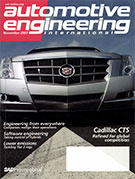Magazine

SAE Off-Highway Engineering 2012-09-06
2012-09-06
The big engine that could With the stringent EPA 2015 regulations on large diesel engines for locomotive, marine, and stationary generator applications, the need for NOx reduction via urea SCR catalyst arises given the proven performance of urea SCR. Monitoring hydraulics Component producers and vehicle service providers offer their views of hydraulic diagnostics as the industry moves toward real-time, intelligent health monitoring, predictive failure software algorithms, and wireless notification. Engine management expands from minute movements to full vehicle Electronic controls grow in complexity as engine designers extend their scope to include hydraulics.



















